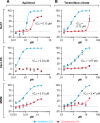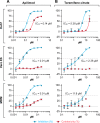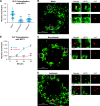The phosphatidylinositol-3-phosphate 5-kinase inhibitor apilimod blocks filoviral entry and infection
- PMID: 28403145
- PMCID: PMC5402990
- DOI: 10.1371/journal.pntd.0005540
The phosphatidylinositol-3-phosphate 5-kinase inhibitor apilimod blocks filoviral entry and infection
Abstract
Phosphatidylinositol-3-phosphate 5-kinase (PIKfyve) is a lipid kinase involved in endosome maturation that emerged from a haploid genetic screen as being required for Ebola virus (EBOV) infection. Here we analyzed the effects of apilimod, a PIKfyve inhibitor that was reported to be well tolerated in humans in phase 2 clinical trials, for its effects on entry and infection of EBOV and Marburg virus (MARV). We first found that apilimod blocks infections by EBOV and MARV in Huh 7, Vero E6 and primary human macrophage cells, with notable potency in the macrophages (IC50, 10 nM). We next observed that similar doses of apilimod block EBOV-glycoprotein-virus like particle (VLP) entry and transcription-replication competent VLP infection, suggesting that the primary mode of action of apilimod is as an entry inhibitor, preventing release of the viral genome into the cytoplasm to initiate replication. After providing evidence that the anti-EBOV action of apilimod is via PIKfyve, we showed that it blocks trafficking of EBOV VLPs to endolysosomes containing Niemann-Pick C1 (NPC1), the intracellular receptor for EBOV. Concurrently apilimod caused VLPs to accumulate in early endosome antigen 1-positive endosomes. We did not detect any effects of apilimod on bulk endosome acidification, on the activity of cathepsins B and L, or on cholesterol export from endolysosomes. Hence by antagonizing PIKfyve, apilimod appears to block EBOV trafficking to its site of fusion and entry into the cytoplasm. Given the drug's observed anti-filoviral activity, relatively unexplored mechanism of entry inhibition, and reported tolerability in humans, we propose that apilimod be further explored as part of a therapeutic regimen to treat filoviral infections.
Conflict of interest statement
The authors have declared that no competing interests exist.
Figures









References
-
- La Vega de M-A, Stein D, Kobinger GP. Ebolavirus Evolution: Past and Present. PLoS Pathog. 2015;11: e1005221 doi: 10.1371/journal.ppat.1005221 - DOI - PMC - PubMed
-
- Ebola Situation Report. 2016 Mar.
-
- Qiu X, Wong G, Audet J, Bello A, Fernando L, Alimonti JB, et al. Reversion of advanced Ebola virus disease in nonhuman primates with ZMapp. Nature. 2014;514: 47–53. doi: 10.1038/nature13777 - DOI - PMC - PubMed
-
- Misasi J, Gilman MSA, Kanekiyo M, Gui M, Cagigi A, Mulangu S, et al. Structural and molecular basis for Ebola virus neutralization by protective human antibodies. Science. American Association for the Advancement of Science; 2016;351: 1343–1346. doi: 10.1126/science.aad6117 - DOI - PMC - PubMed
-
- Corti D, Misasi J, Mulangu S, Stanley DA, Kanekiyo M, Wollen S, et al. Protective monotherapy against lethal Ebola virus infection by a potently neutralizing antibody. Science. American Association for the Advancement of Science; 2016;351: 1339–1342. doi: 10.1126/science.aad5224 - DOI - PubMed
MeSH terms
Substances
Grants and funding
LinkOut - more resources
Full Text Sources
Other Literature Sources
Medical
Molecular Biology Databases

